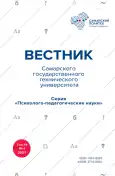Blended learning module for universities and extended education programs
- Authors: Egorova E.P.1, Abashkin A.A.1, Mosin V.G.1
-
Affiliations:
- Samara State Technical University
- Issue: Vol 18, No 4 (2021)
- Pages: 129-138
- Section: Theory and methodology of education
- URL: https://journals.rcsi.science/1991-8569/article/view/81006
- DOI: https://doi.org/10.17673/vsgtu-pps.2021.4.10
- ID: 81006
Cite item
Full Text
Abstract
The paper is devoted to the actual problem of the implementation of educational programs of higher education in the conditions of digitalization and the transition to online forms of teaching. As a basic model, a mixed form of teaching is considered, when all the information part of the educational course is brought online, but at the same time all practical classes are carried out in the classroom in the traditional contact form. The paper examines in detail the procedure for creating, implementing and operating an educational module implemented in a mixed hybrid format and actually provides a teaching technology that can be widely replicated in a wide variety of educational fields. As an example, the study considers the educational module of the block «Theoretical and probabilistic methods of data analysis», which includes video content of 100–150 clips lasting 8–10 minutes, a communication medium, printed materials and step-by-step operating instructions. The issues of content production, its time and content formats are considered. In addition, the issues of creating and operating a communication environment in which the educational process takes place are considered. Special attention is paid to the issues of monitoring the activities of all participants in the educational process: both students and teachers, as well as content creators, a media group working on its production and maintenance. In addition, the risks of the project are analyzed, recommended risk management measures are proposed. The module is implemented in the Blended Learning format and is designed to be used in educational programs of higher professional education and in extended education programs. Its subject matter (probability theory and data analysis) is presented in such a way that, once implemented, it will be in demand in a wide range of educational areas: from sociology, biology and medicine to economics, energy, construction and mechanical engineering.
Full Text
##article.viewOnOriginalSite##About the authors
Egorova P. Egorova
Samara State Technical University
Email: ira.egorova81@yandex.ru
Cand. Phys. and Math. Sci., Associate Professor of Higher Mathematics Department
Russian Federation, 244, Molodogvardeyskaya st., Samara, 443100, RussiaAnton A. Abashkin
Samara State Technical University
Email: samcocaa@rambler.ru
Cand. Phys. and Math. Sci., Associate Professor of Higher Mathematics Department
Russian Federation, SamaraVladimir G. Mosin
Samara State Technical University
Author for correspondence.
Email: yanbacha@yandex.ru
Cand. Phys. and Math. Sci., Associate Professor of Higher Mathematics Department
Russian Federation, SamaraReferences
- Alieva E.F., Alekseeva A.S., Vandanova E.L., Kartashova E.V., Rezapkina G.V. Tsifrovaya perepodgotovka: obucheniye rukovoditeley obrazovatelnykh organizatsiy [Digital retraining: training of heads of educational organizations]. Obrazovatel’naya politika. 2020. No. 1 (81). Рр. 54–61.
- Antonova D.A., Ospennikova E.V., Spirin E.V. Tsifrovaya transformatsiya sistemy obrazovaniya. Proyektirovaniye resursov dlya sovremennoy tsifrovoy uchebnoy sredy kak odno iz eye osnovnykh napravleniy [Digital transformation of the education system. Designing resources for a modern digital learning environment as one of its main directions]. Vestnik Permskogo gosudarstvennogo gumanitarno-pedagogicheskogo universiteta. Seriya: Informatsionnyye komp’yuternyye tekhnologii v obrazovanii. 2018. No. 14. Рр. 5–37.
- Nikolaeva E.N., Egorova I.P. Rol mediatekhnologiy v povyshenii kachestva podgotovki spetsialistov [The role of media technologies in improving the quality of training of specialists]. Neftegazovyy kompleks: problemy i innovatsii. Tezisy III nauchno-prakticheskoy konferentsii s mezhdunarodnym uchastiyem. Samara, 2018. Р. 193.
- Boronenko T.A., Kaisina A.V., Fedotova V.S. Razvitiye tsifrovoy gramotnosti shkolnikov v usloviyakh sozdaniya tsifrovoy obrazovatelnoy sredy [Development of digital literacy of schoolchildren in the conditions of creating a digital educational environment]. Prospects of science and educat Perspektivy nauki i obrazovaniya. 2019. No. 2 (38). Рр. 167–193.
- Butsyk S.V. «Tsifrovoye» pokoleniye v obrazovatelnoy sisteme rossiyskogo regiona: problemy i puti resheniya [«Digital» generation in the educational system of the Russian region: problems and solutions]. Otkrytoye obrazovaniye. 2019. No. 1. Рр. 27–33.
- Gabel E. Tsifrovaya transformatsiya shkolnogo obrazovaniya. Mezhdunarodnyy opyt, trendy, globalnyye rekomendatsii [Digital transformation of school education. International experience, trends, global recommendations]. Natsional’nyy issledovatel’skiy universitet «Vysshaya shkola ekonomiki», Institut obrazovaniya (Sovremennaya analitika obrazovaniya. № 2 (23)). Moscow: NIU VShE, 2019. 108 p.
- Murphy J., Chang M., Suaray K. Student performance and attitudes in a collaborative and flipped Linear Algebra course. International Journal of Mathematical Education in Science and Technology. 2016. No. 47(5). Pp. 653–673.
- Nicolete P., Bilessimo M.S., Cristiano M.A. Technology Integration Actions in Mathematics teaching in Brazilian Basic Education: Stimulating STEM disciplines. Revista de Educación a Distancia. 2017. Vol. 7. No. 52. 22 p.
- Zaytseva Zh.I., Kotlyar L.M., Fomenko L.B. Organizatsiya samostoyatel’noy raboty po matematike s pomoshch’yu sovremennykh informatsionnykh tekhnologiy [Organi zation of independent work in mathematics with the help of modern information tech nologies]. Fundamental’nyye issledovaniya. 2004. No. 5. Рр. 15–19.
- Harrison M. Blended learning. An Epic White Paper. Summer 2001. www.epic.co.uk (accessed September 21, 2021).
- Driskoll M. Blended learning: Let’s get beyond the hype. E-Learning. 2002. Vol. 1. No. 4. Рp. 1–3.
- Hoffman J. Blended Learning Case Study. ASTD’s Online Magazine All About E-Learning. 2001. https://studylib.net/doc/7424204/blended-learning-case-study (accessed September 22, 2021).
- Singh H. Building effective blended learning programs. Educational Technology. 2003. No. 43. Pp. 51–54.
Supplementary files







